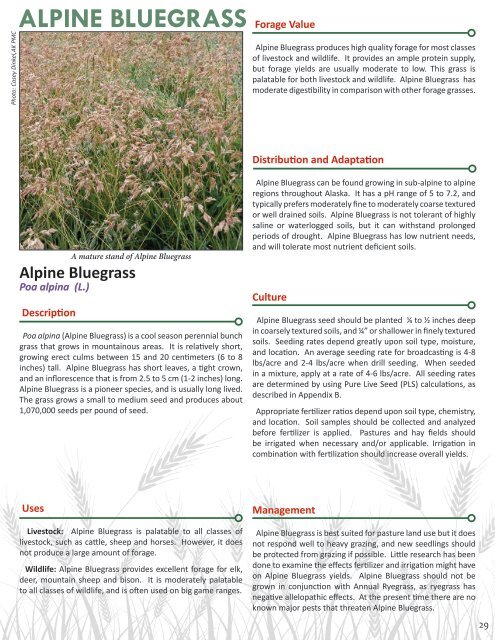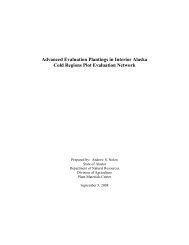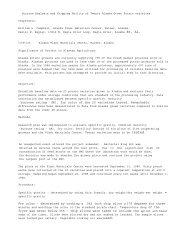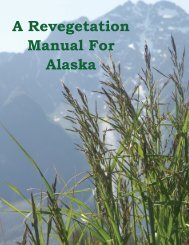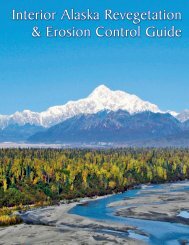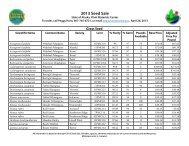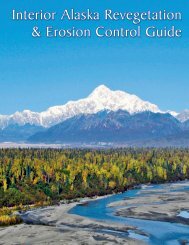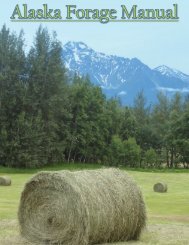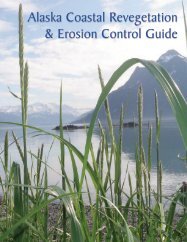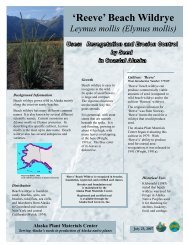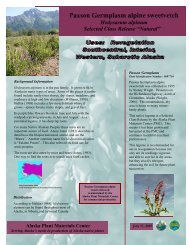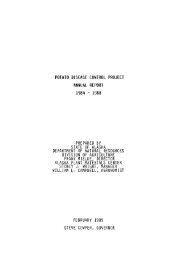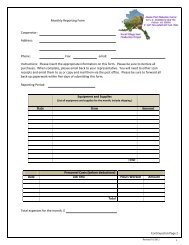Alaska Forage Manual - Alaska Plant Materials Center - State of ...
Alaska Forage Manual - Alaska Plant Materials Center - State of ...
Alaska Forage Manual - Alaska Plant Materials Center - State of ...
You also want an ePaper? Increase the reach of your titles
YUMPU automatically turns print PDFs into web optimized ePapers that Google loves.
Photo: Casey Dinkel,AK PMC<br />
ALPINE BLUEGRASS<br />
<strong>Forage</strong> Value<br />
Alpine Bluegrass produces high quality forage for most classes<br />
<strong>of</strong> livestock and wildlife. It provides an ample protein supply,<br />
but forage yields are usually moderate to low. This grass is<br />
palatable for both livestock and wildlife. Alpine Bluegrass has<br />
moderate digestibility in comparison with other forage grasses.<br />
Distribution and Adaptation<br />
A mature stand <strong>of</strong> Alpine Bluegrass<br />
Alpine Bluegrass<br />
Poa alpina (L.)<br />
Description<br />
Poa alpina (Alpine Bluegrass) is a cool season perennial bunch<br />
grass that grows in mountainous areas. It is relatively short,<br />
growing erect culms between 15 and 20 centimeters (6 to 8<br />
inches) tall. Alpine Bluegrass has short leaves, a tight crown,<br />
and an inflorescence that is from 2.5 to 5 cm (1-2 inches) long.<br />
Alpine Bluegrass is a pioneer species, and is usually long lived.<br />
The grass grows a small to medium seed and produces about<br />
1,070,000 seeds per pound <strong>of</strong> seed.<br />
Alpine Bluegrass can be found growing in sub-alpine to alpine<br />
regions throughout <strong>Alaska</strong>. It has a pH range <strong>of</strong> 5 to 7.2, and<br />
typically prefers moderately fine to moderately coarse textured<br />
or well drained soils. Alpine Bluegrass is not tolerant <strong>of</strong> highly<br />
saline or waterlogged soils, but it can withstand prolonged<br />
periods <strong>of</strong> drought. Alpine Bluegrass has low nutrient needs,<br />
and will tolerate most nutrient deficient soils.<br />
Culture<br />
Alpine Bluegrass seed should be planted ¼ to ½ inches deep<br />
in coarsely textured soils, and ¼” or shallower in finely textured<br />
soils. Seeding rates depend greatly upon soil type, moisture,<br />
and location. An average seeding rate for broadcasting is 4-8<br />
lbs/acre and 2-4 lbs/acre when drill seeding. When seeded<br />
in a mixture, apply at a rate <strong>of</strong> 4-6 lbs/acre. All seeding rates<br />
are determined by using Pure Live Seed (PLS) calculations, as<br />
described in Appendix B.<br />
Appropriate fertilizer ratios depend upon soil type, chemistry,<br />
and location. Soil samples should be collected and analyzed<br />
before fertilizer is applied. Pastures and hay fields should<br />
be irrigated when necessary and/or applicable. Irrigation in<br />
combination with fertilization should increase overall yields.<br />
Uses<br />
Livestock: Alpine Bluegrass is palatable to all classes <strong>of</strong><br />
livestock, such as cattle, sheep and horses. However, it does<br />
not produce a large amount <strong>of</strong> forage.<br />
Wildlife: Alpine Bluegrass provides excellent forage for elk,<br />
deer, mountain sheep and bison. It is moderately palatable<br />
to all classes <strong>of</strong> wildlife, and is <strong>of</strong>ten used on big game ranges.<br />
Management<br />
Alpine Bluegrass is best suited for pasture land use but it does<br />
not respond well to heavy grazing, and new seedlings should<br />
be protected from grazing if possible. Little research has been<br />
done to examine the effects fertilizer and irrigation might have<br />
on Alpine Bluegrass yields. Alpine Bluegrass should not be<br />
grown in conjunction with Annual Ryegrass, as ryegrass has<br />
negative allelopathic effects. At the present time there are no<br />
known major pests that threaten Alpine Bluegrass.<br />
29


